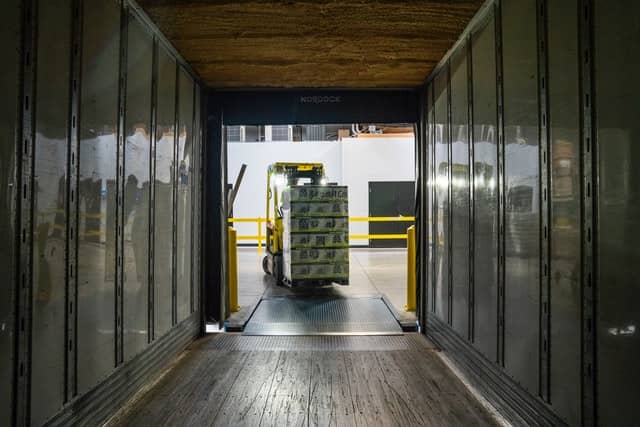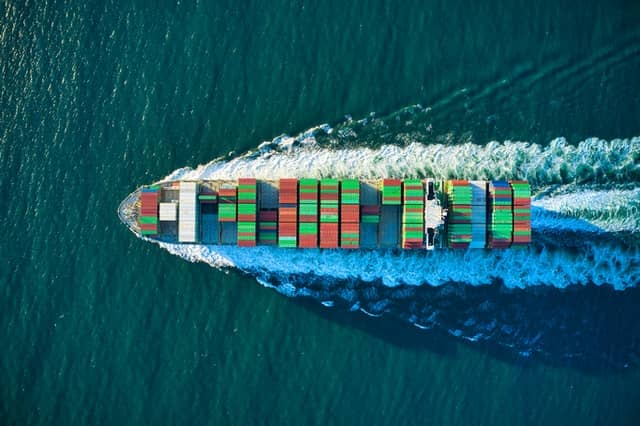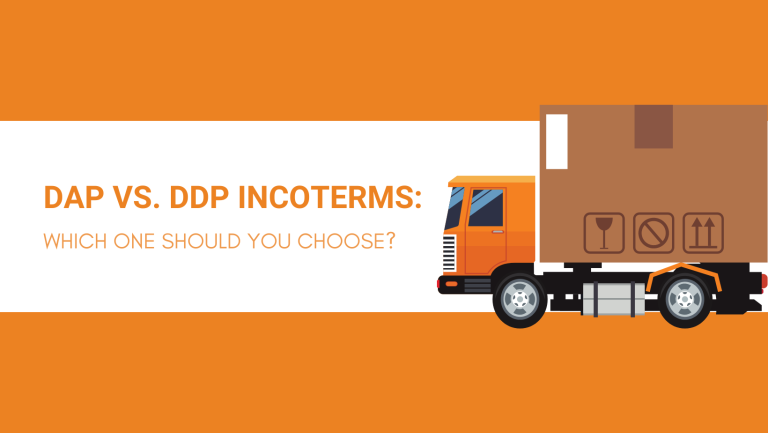If you’re interested in learning more about DAP vs. DDP, you’ve landed on the right spot. The International Chamber of Commerce or ICC established 11 different Incoterms, and DAP and DDP are two of them.
The DAP and DDP Incoterms are the two trade agreements that are the most beneficial for the buyer. Under these Incoterms, almost all costs and risk fall on the seller.
So, is DAP or DDP the best choice for buyers?
Let’s jump in and see!
What Is DAP Incoterms?
DAP stands for Delivered At Place. Knowing this, we can define DAP Incoterms as a trade agreement between the buyer and seller that places the majority of the risk and responsibility on the seller. DAP can be used for any mode of transport.
Under DAP terms, the seller is obliged to deliver the cargo at the named place of destination, which is usually the buyer’s port.
With a DAP agreement, the seller covers the shipping costs and export customs duties and taxes. The buyer covers only import duties and unloading at the final destination.

DAP Seller’s Responsibilities
Under DAP, the largest part of the costs and risk is placed on the seller:
- Preparing and packaging the goods
- Loading at origin (typically the seller’s warehouse)
- Providing an invoice and all associated documentation
- Delivering the products to the port of export
- Export duties, taxes, and custom clearance
- Unloading from the truck (or pre-carrier) and loading onto the main carriage (ship, plane)
- Organizing and paying for the main carriage
- Insurance (not obligatory but it will be the seller’s liability)
- Unloading the cargo at the import port
- Loading on truck
- Delivering to the named place of destination
DAP Buyer’s Responsibilities
The buyer’s responsibilities start once the seller delivers the goods at the named place:
- Import duties and taxes
- Unloading at the final destination
- Paying for the goods
What Is DDP Incoterms?
DDP is a shortcut for Delivered Duty Paid. DDP Incoterms is an agreement between the buyer and seller that places all the costs and risks on the seller. DDP Incoterms can be used for all transport modes.

With DDP shipping, the seller has maximum responsibility and has to deliver the goods at the named place of destination in the buyer’s country. The greatest difference between DAP and DDP is that under DDP, the seller is also responsible for import duties and taxes.
DDP Seller’s Responsibilities
Under DDP Incoterms, the seller carries maximum responsibilities and costs:
- Packaging the goods for shipment
- Providing a bill or invoice
- Loading the goods on the pre-carriage
- Preparing the goods for export
- Covering export duties and taxes
- Delivering the goods to the port
- Loading the goods on the main carriage
- Paying and arranging the transportation
- Insurance (not obligatory but the seller carries liability)
- Importing costs and procedure
- Paying taxes like VAT (value-added tax) if applicable
- Unloading at the destination port
- Carriage and delivering the goods to the named place of destination (usually the buyer’s premises)
DDP Buyer’s Responsibilities
The buyer has minimum responsibility under DDP Incoterms:
- Paying for the goods as per the agreed product pricing
- Unloading goods at the named place of destination

These are the only two responsibilities a buyer has under DDP. However, if the seller doesn’t have any experience with the import procedure in the buyer’s country, the buyer often has to help them.
DAP Pros and Cons for Sellers
Let’s start with the advantages and disadvantages of DAP Incoterms for sellers:
Pros:
- Sellers don’t do import duty, buyers are responsible for that
- Sellers don’t need experience in importing to the buyer’s country
- They don’t take care of unloading at the named destination
- Insurance isn’t obligatory
Cons:
- Sellers cover all the risk up until unloading (packaging, loading, export, main carriage, unloading, delivery to the named place of destination)
- Sellers cover all costs except import duties and customs clearance and unloading at the final destination
DAP Pros and Cons for Buyers
Now, let’s take a look at the DAP advantages and disadvantages for buyers:
Pros:
- Most of the responsibility, risks, and costs fall on the back of the seller
- No need to worry about packaging, loading, main carriage, unloading, and carriage to the final destination
Cons:
- Buyers have to organize and cover the costs for import and customs clearance
- Buyers cover the costs and take liability for unloading the goods at the final destination

DDP Pros and Cons for Sellers
Next, let’s see all the benefits and disadvantages of DDP for sellers:
Pros:
- Sellers control the entire shipping process
- The ability to choose their own service providers at each step of the delivery
- Sellers are not responsible for unloading at the buyer’s premises
- Insurance is not obligatory (but liability stays with the seller)
Cons:
- Sellers cover almost all risks, responsibilities, and costs
- Sellers also have to arrange import and cover all import duties and taxes
- VAT taxes often apply and they can vary from one country to another
DDP Pros and Cons for Buyers
Last but not least, let’s look at the pros and cons of DDP for buyers:
Pros:
- Buyers have no risks, responsibilities, or costs until the final unloading at the named place of destination
- No need to worry about export, import, or transport
Cons:
- Buyers have no control over the delivery process
- Buyers cover the cost of unloading
DAP vs. DDP Features Comparison
To simplify the comparison of DAP and DDP, let’s take a look at their features:
Mode of transport:
DAP – all transport modes
DDP – all transport modes
Export, duties, and customs clearance:
DAP – the seller is responsible
DDP – the seller is responsible
Delivery site:
DAP – named place of destination (the buyer’s premises)
DDP – named place of destination (the buyer’s premises)
Main carriage:
DAP – the seller’s responsibility
DDP – the seller’s responsibility
Unloading at port:
DAP – the seller is responsible
DDP – the seller is responsible

Import, duties, and customs clearance:
DAP – the buyer is the importer on record
DDP – the seller is the importer on record
Carriage to final destination:
DAP – the seller’s responsibility
DDP – the seller’s responsibility
Final unloading:
DAP – the buyer’s responsibility
DDP – the buyer’s responsibility
FAQs about DAP and DDP
It’s time to bring more clarity and dive deep into the subject. Let’s take a look at some of the most frequently asked questions on DAP vs. DDP:
What Do DAP Shipping Terms Mean?
DAP Incoterms stand for Delivered At Place. Under DAP shipping terms, the seller takes responsibility, liability, and covers all costs up until import and unloading at the final destination.
DAP can be used for any mode of transport, not just sea and inland waterway.
What Is DDP Shipping?
DDP shipping means trading internationally under DDP Incoterms. Under DDP, all risks, responsibilities, and costs (including import) except unloading at the final destination are placed on the seller.
Is DAP Better than DDP?
Generally speaking, DDP places more responsibilities and costs on the seller than DAP.
However, DAP can be useful for determining your real product pricing. With DAP, you can calculate all your costs and come up with a genuine way to determine your sales product pricing.
Are DAP and DDP the Same?
No. DAP stands for Delivered At Place, and it obliges the seller to take responsibility and cover all costs of the delivery except import and unloading. DDP stands for Delivered Duty Paid and it means that the seller will cover everything including import duties and taxes.
The only thing the seller won’t cover under DDP is the unloading at the final destination.
Are DAP and CIF the Same?
No. DAP stands for Delivered At Place, while CIF stands for Carriage, Insurance & Freight. DAP is used for all modes of transport, while CIF is only for sea and inland waterways.

Finally, DAP covers unloading, carriage, and delivery to destination, while CIF seller responsibilities end with paying freight and insuring the cargo on board.
Does DAP Include Customs Clearance?
Under DAP Incoterms, the seller takes care of export duties and customs clearance, and the buyer covers the import.
Does DDP Include Customs Clearance?
Yes. Under DDP Incoterms, the seller takes care of both export and import duties and customs clearance.
What Is the Difference between DAP and DDP Shipping?
The two main differences between DAP and DDP Incoterms are:
- With DDP, the seller covers the import costs and customs clearance
- Under DAP, the import duties and taxes fall on the buyer
What Is the Difference between DAP and DAT Incoterms?
DAT stands for Delivered At Terminal, and this is an older Incoterms that’s not that used anymore. DAT obliges the seller to deliver the goods and unload them on the terminal port.
From then on, the buyer takes over the responsibility and covers the import and delivery to the place of destination.
What Is the Difference between DDP and Ex-Works?
DDP and Ex-Works are practically polar opposites. DDP places maximum responsibilities on the seller, while Ex-Works or EXW places almost all responsibilities on the buyer.
Under DDP, the seller is responsible for everything except unloading. Under EXW Incoterms, the seller just needs to provide an invoice and make the goods accessible for pickup at their premises.
DAP vs. DDP vs. CIF – What Are the Differences?
CIF stands for Carriage, Insurance & Freight, DDP stands for Delivered Duty Paid, and DAP stands for Delivered At Place.
Firstly, DAP and DDP Incoterms are used for all transport modes. CIF, on the other hand, is used only for sea and inland waterway transport.
Secondly, CIF places responsibility on the seller such as main carriage and insurance during transport, but here it ends. Then, the buyer is responsible for unloading, importing, etc.
With DAP, the seller has to deliver the goods to the final destination, but they’re not responsible for the import and unloading.
And, finally, DDP is the most buyer-friendly since it places all costs and responsibilities on the seller except unloading at the final destination.
What Are DDP and DDU?
DDP is an Incoterms that’s currently being used and it stands for Delivered Duty Paid. DDU stands for Delivered Duty Unpaid, but it has been removed since the Incoterms 2010. Instead of DDU, now we have DAP – they place the same responsibilities on the seller – all except import.
Who Pays VAT on DDP Terms?
Under DDP, the seller covers all import duties and taxes as well as all other taxes such as VAT (value-added tax). Depending on the country, the average VAT is usually 15% or higher.

What Are the 11 Incoterms?
The 11 Incoterms are enforced by the International Chamber of Commerce or the ICC, and they get updated every 10 years. They’re a set of agreements for international trade between buyers and sellers, all with different conditions.
Here are all of them:
- Delivered At Place (DAP)
- Delivered at Place Unloaded (DPU)
- Delivered Duty Paid (DDP)
- Carriage Paid To (CPT)
- Cost Insurance and Freight (CIF)
- Carriage and Insurance Paid (CIP)
- Cost and Freight (CFR)
- Free On Board (FOB)
- Ex Works (EXW)
- Free Carrier (FCA)
- Free Alongside Ship (FAS)
Does DDP Cover Import Tax?
Yes, with a DDP agreement, the seller is responsible for organizing the import process, customs clearance, and covering all import duties and taxes.
Who Is Importer Under DDP?
The seller acts as the importer on record under DDP shipping terms. For sellers who don’t have any experience importing in the buyer’s country, the DDP Incoterms might not be the best choice. They could use DAP instead.
Is CIF the Same as DDP?
Not at all. CIF Incoterms is only for sea and inland waterway transport, while DDP can be used for all transport modes. CIF stands for Cost, Insurance & Freight, and it obliges the seller to cover the main carriage plus insurance on board. DDP, on the other hand, stands for Delivered Duty Paid, and it places maximum responsibilities on the sellers.
Who Pays DAP Freight?
Under DAP Incoterms, the seller is responsible for organizing the freight and covering the costs for the main carriage.

Summary
If you’ve come to the end of this blog, it should now be much easier to choose between DAP and DDP Incoterms.
These two Incoterms place maximum responsibilities on the seller, which could be beneficial if you’re a new buyer.
And, if you’re a buyer who’s never dealt with import before, we suggest you choose DDP and let the seller take care of importing in your country.
If you want to buy and import your first bulk order, get in touch. We’re an expert product sourcing agent in China and we can hold your hand through the entire import process. Take advantage of our free sourcing quote – you have nothing to lose.
If you have any other questions about DAP vs. DDP, we’d be glad to answer them below.


What nice answer